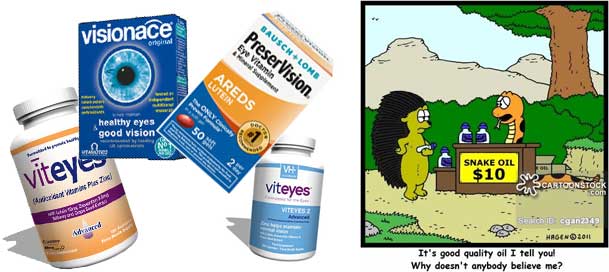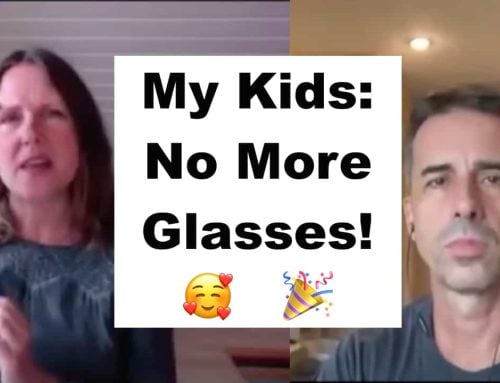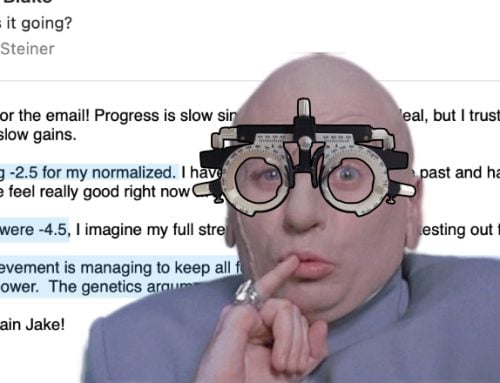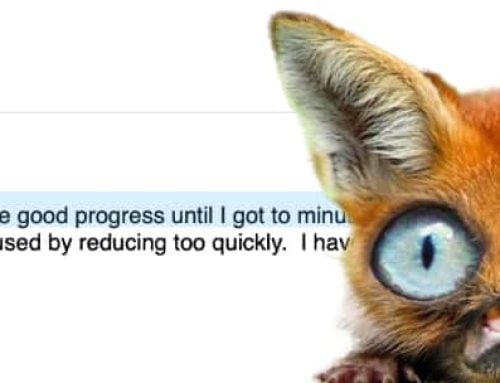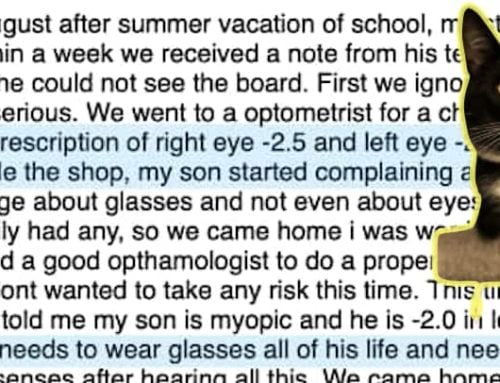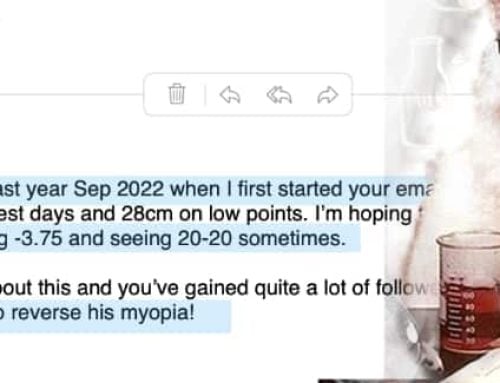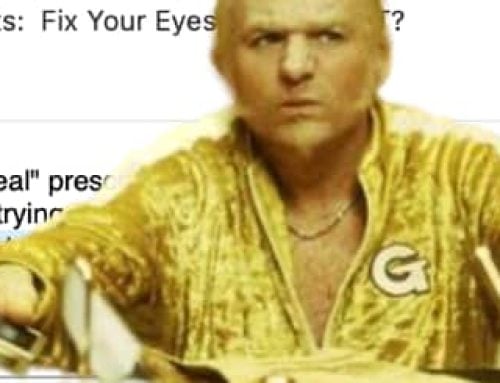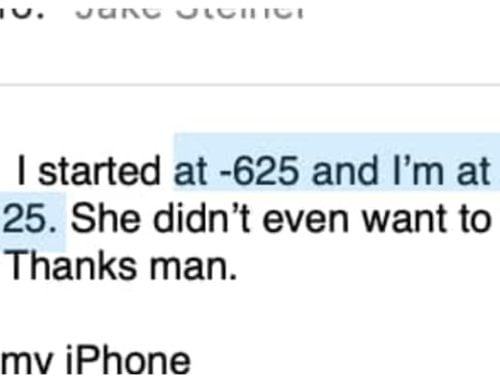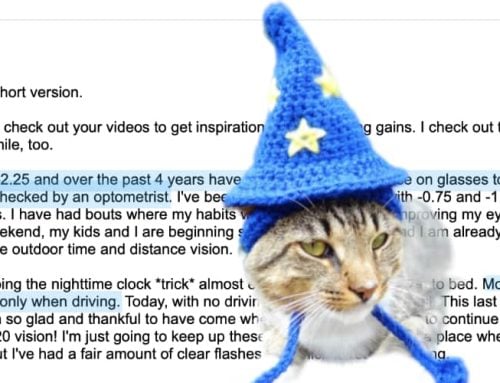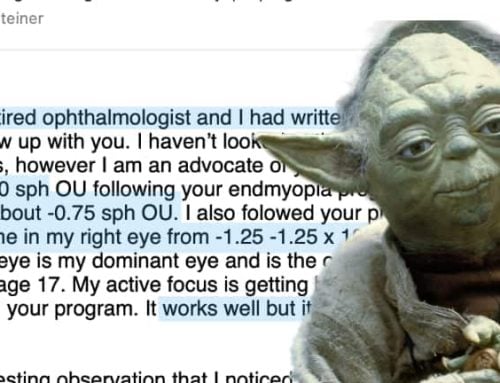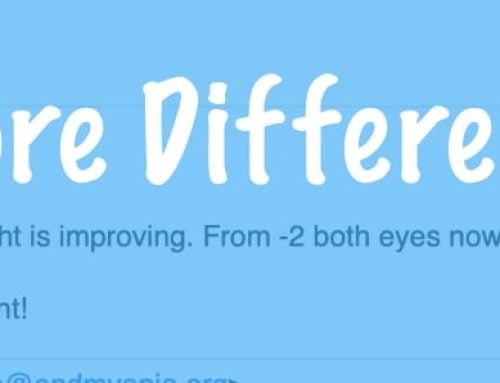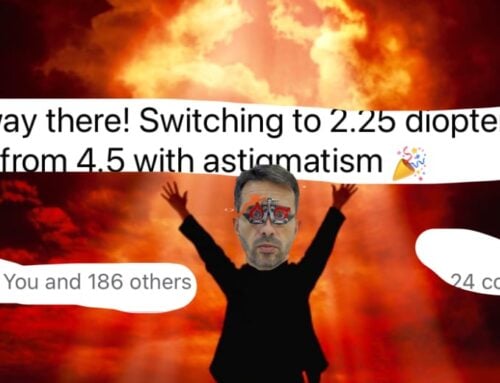Kim writes in the forum:
So, it’s been about 3 weeks now with my -4.25 (L) and -4.75 (R) normalized prescription. For a while now, I could only see around 20/50 and sometimes 20/40. Starting around middle of last week, I was able to clearing the texts on the Snellen chart, but it has been a bit inconsistent. When I put on my glasses, I could probably only see around 20/50, but then slowly things clear up and I can see 20/25. Once I blink, I could probably only see 20/30 or 20/40. When I blink again, I sometimes could see 20/25 and 20/20 (even 20/15). Then maybe it goes back to seeing 20/30 when I blink again.
I’m putting this one in today’s blog post, just for a bit of motivation.
Because of course the answer to the blog title is, no. You won’t go from 20/50 vision to 20/15 vision in three weeks. Anybody who promises you that, is part of this contingent:
Promises, promises.
What Kim is experiencing however, is pretty cool anyway.
It’s what you might find yourself, when you get out of the maximum prescriptions you get from the optometrist, and start to challenge your eyesight. The eye is a dynamic system. By its very design it uses environmental stimulus to adjust itself for proper vision.
Just like your muscles get bigger if you lift heavy things, and your endurance gets better if you run, your eyes will respond to a well placed challenge for clearer eyesight.
Let’s dive in what happens with various prescription strengths:
If you spend all your time behind that maximum optometrist prescription, you are always in the process of your eyesight getting “worse” (really just adjusting to that lens stimulus). When you reduce that prescription to be just a bit less than you think you need, rather than a bit more, you start to get into the process of your eyesight getting “better” (adjusting to the new stimulus).
So what Kim is quantifying, is his eyesight looking to address what is now a perceived shortcoming in eyesight (since he lowered the prescription, he isn’t getting as much clarity as before). He started at 20/50, and by continually challenging that distance he is starting to get better results. He can’t do it consistently just yet, since parts of the biology, and parts of the visual cortex aren’t able to provide the desired clarity without effort. But they are doing something very exciting, in starting to respond to the challenge created by the lower prescription.
It’s the short term effects of stimulus, which you should always check against an objective measuring tool (like an eye chart). Measure, and record. Keep a log.
On another note, this short term effect is touted quite a bit online, and not in a good way.
This phenomenon gets abused by Internet snake oil sales.
Or in some cases not abused, just misunderstood.
I’m talking about eye exercises. People try those, they get that short term response from the eye, and they imagine that they can go all the way back to 20/20 with some exercise program.
Except, no.
That short term stimulus response actually creates strain.
Strain a bit like going to the gym is strain. Lifting weights doesn’t make you stronger. The rest period after lifting weights does. Eating right, consistently exercising, having a whole routine around the gym makes you stronger.
Eye exercises aren’t like lifting weights, but the analogy sort of works.
You can reproduce Kim’s results by using a correctly lowered prescription, and some focal stimulus. And you can improve your eyesight long term with this, by doing it regularly, and getting “rest” in-between those challenges. (rest being, going outside, looking at a distance, reducing the close-up impact)
This all might helpful for you to understand things like Bates Method and various other schemes that circulate. They have a little piece of the puzzle. One step in the right direction.
To avoid going one step forward and then two steps back like eye exercises tend to, you’ll want to incorporate dealing with the root of the problem. (too much close-up, and the wrong glasses) Do that and continue to repeat what Kim experienced day after day, and before long you’ll notice that the 20/50 is now consistently 20/40, and that the 20/20 and better “flashes” come easier and more often.
That’s indication of real progress!
Hopefully, helpful. Enjoy the journey. ;-)
Cheers,
– Jake


